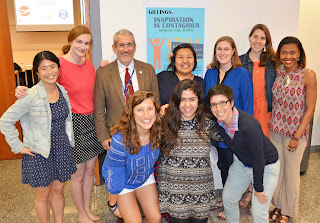Welcome New and Continuing Students!
A warm welcome to new and continuing students at the Gillings School of Global Public Health this fall semester 2016.
This is Jim Herrington and I have the humble honor of leading the Gillings Global Gateway™team here at the School. The mission of the Gillings Global Gateway™is to promote and facilitate the global public health activities of the School by connecting faculty and students with research, teaching, and service opportunities in global public health, both domestically and overseas. Naya Villarreal, Program Coordinator, oversees the Global Health Certificate, Global Internships and Funding, and Student International Travel requirements, among other programs in the Gillings Global Gateway™and is a great resource for you. Dr. Dilshad Jaff, is a Kurdish physician who worked previously for the International Committee of the Red Cross (ICRC) and serves as an Advisor to the Gillings Global Gateway™ on Conflict Prevention and Disaster Preparedness research and programs. Elisia Black is our administrative assistant who will make you feel welcome when you stop by our offices in 104 Rosenau Hall to seek advice, ask questions, or share your ideas about our global public health. Also, be sure to check out the Student Global Health Committee (SGHC), led by Christine Pettitt-Schieber, which is "committed to creating awareness and understanding of global health issues among the UNC community through education, advocacy, and service."
 |
| A few SGHC members plus Jim and Naya (in glasses) |
What's in a Name?
So, what's in a name? What does it mean to you as a student that UNC Chapel Hill is the only public health school in the US (and the world) with "global" in its name?For starters, just consider the fact that there are over 100,000 daily commercial international flights around the world and over 29,000 daily domestic commercial flights in the US alone. According to the World Bank, air transport carried almost half the world's population or 3.44 billion passengers in 2015. As you will learn, "person, place, and time" are central tenets to understanding how a disease is distributed in a family, community, or nation. We have all three when considering air transport.
"Breakbone Fever"
 |
| https://en.wikipedia.org/wiki/Aedes |
 |
| USS North Carolina (1941-1947) had a complement of 2,339 men. |
There are five dengue virus serotypes and they are all transmitted in a human-mosquito-human cycle, primarily by the daytime biting, anthrophilic, female Aedes aegypti mosquito, also a vector of Zika virus (a disease with very similar symptoms).
Dengue illness typically presents 4-7 days after infection (indicating rapid viral replication) as a severe fever with muscle and joint aches (hence the nickname “breakbone fever”) and, less frequently, as fatal dengue hemorrhage fever (mainly in children and adolescents), a result of low blood platelets and blood plasma loss. The physiopathology for this shock syndrome is poorly understood.
 |
| Discarded containers favored by female Aedes aegypti. Photo: CNN |
Dengue is now endemic in most tropical latitudes around the globe where Aedes aegypti mosquitoes are present. The female Aedes aegypti mosquito can lay eggs in small containers, such as discarded bottle caps, tin cans, and tires. She is more common in urban tropical environments, given her preference for humans as blood meals (blood protein is necessary for egg production).
 Environmental control and health behavior are the primary keys to preventing dengue infection, given there is no treatment for the illness nor a vaccine against the virus, though Drs. Ralph Baric and Doug Widman, UNC Department of Epidemiology, are actively conducting research for a suitable vaccine candidate.
Environmental control and health behavior are the primary keys to preventing dengue infection, given there is no treatment for the illness nor a vaccine against the virus, though Drs. Ralph Baric and Doug Widman, UNC Department of Epidemiology, are actively conducting research for a suitable vaccine candidate. So, I hope using dengue and the Aedes aegypti mosquito help illustrate what "global" means in terms of person, place, and time, and why this is important to you as a student of "global" public health, whether you are working in Sampson County, North Carolina, or Sédhiou, Senegal.
Very best wishes for a successful year at Gillings!
Jim

